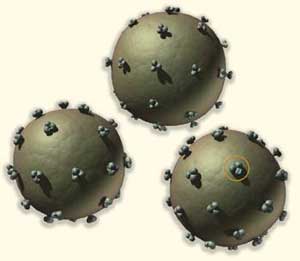Thai health experts warn that the country is facing a threat from new strains of HIV, which could spread the HIV/AIDS epidemic more rapidly.
The Thai National HIV and Biological Information Center discovered this new virus strain in late last year. The center has since conducted regular tests to determine whether there are significant mutations in the virus’s genetic structure.
 |
|
AIDS Virus (Image: lanl.gov) |
Experts have concluded that this is the first time a virus combining the E strain of HIV found in Thailand with the C strain from abroad has appeared, representing a serious concern.
Professor Ruengpung, the center’s director, stated that the new E-C virus strain was found in approximately 0.5% of 201 test samples. Most infections with this new virus are concentrated in eastern provinces, such as Rayong and Chonburi.
A report from Johns Hopkins University released at the end of last year also indicated that “combination viruses” could accelerate the spread of the disease.
According to Professor Prasert Thongcharoen, a leading scientist in Thailand specializing in virology, there are currently about 20 rapidly spreading combination virus strains worldwide. The strains of HIV in Thailand are also evolving in a concerning manner towards more combinations.
Professor Reupung further noted that, in addition to the potential for rapid transmission, the combination of strain C with other strains raises concerns about the drug resistance of these combination viruses, impacting current HIV vaccine trials. In Thailand, vaccine trials are only conducted for strains E and B.
Experts emphasize that while trials are ongoing, in light of the emergence of these complex new combination HIV strains, preventative measures must be prioritized.
Gary Lewis, head of the United Nations Office on Drugs and Crime for the South Asia region, urged countries in the Asia-Pacific region to accelerate efforts to combat the HIV/AIDS epidemic, particularly among drug injection users. He pointed out that in some countries, HIV is spreading rapidly among high-risk groups, including drug injection users, thus “immediate action is necessary.”
Speaking at a regional task force meeting coordinated by the United Nations on HIV/AIDS among injection drug users (IDUs) recently held in Kuala Lumpur, Lewis stated: “If we target this group, we have a real opportunity to curb the spread of HIV into the broader community.”
The United Nations estimates that there are currently between 1.3 million and 5.3 million injection drug users in South and Southeast Asia. HIV/AIDS remains rampant among IDUs in several countries, including Malaysia and Vietnam in Southeast Asia, as well as Nepal and Bangladesh in South Asia.
The rate of access to healthcare services among injection drug users is below 5% in most countries in the region. Services include education, needle exchange programs, treatment therapies, and medications such as methadone.
The United Nations recommends that if countries cannot raise this rate from 50% to 80%, they will not be able to effect change in preventing the spread of HIV. To create change, over the next 3 to 5 years, countries need to promote a campaign of “widespread advocacy” within the injection drug user community to prevent the virus’s spread.
CHU HỒNG THẮNG


















































